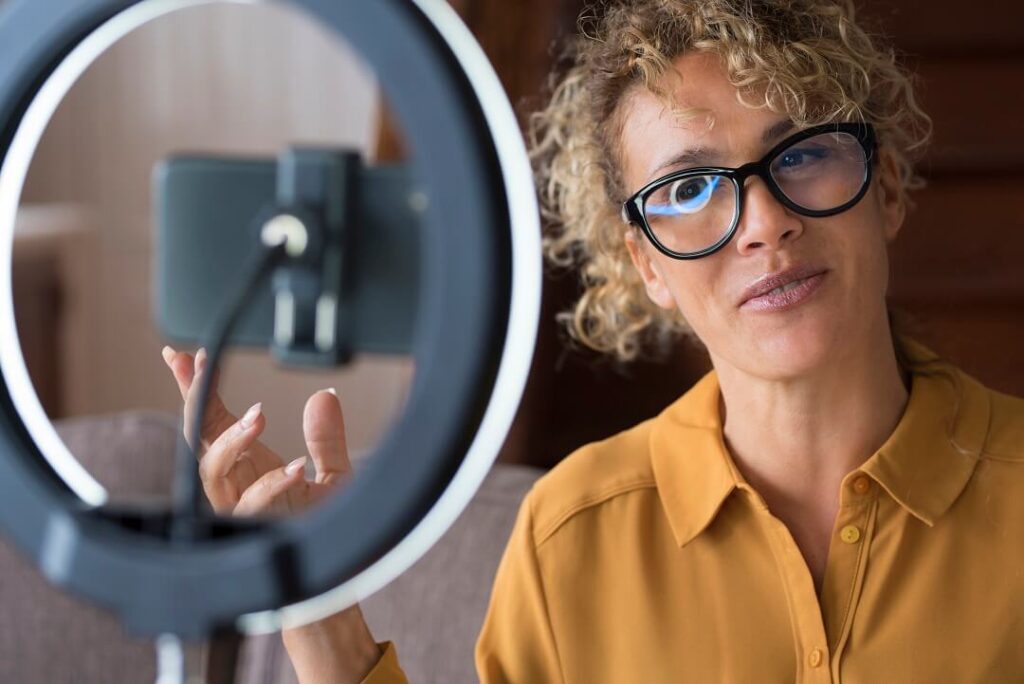Video marketing is growing in popularity and successful businesses are realizing that they need to take advantage of this marketing media. In fact, Invideo reports that 9 out of 10 viewers report they want to see more videos from brands and businesses. However, this means you may need to up your game when it comes to creating marketing videos, beginning with the best lighting for video recording. But how do you get the right lighting for your videos? Here we take a closer look at lighting and how to set up lighting for video marketing.
Key Takeaways
- Good lighting is essential for professional-looking videos; it can be achieved by understanding basic lighting techniques without hiring professionals or investing in expensive equipment.
- Choose the right lighting type based on your budget and location, and set up a three-point lighting system with key, fill, and backlight.
Select a consistent light temperature for all your lights to maintain a balanced appearance in your video. - Minimize glare by adjusting the position of your lights, and avoid mixed lighting to ensure a cohesive look.
- Consider unique challenges when shooting videos outdoors or at your desk, and adapt your lighting accordingly.
Get Our Billion Dollar Mortgage Playbook
Get the proven strategies that helped close Billions of dollars in funded deals!
Importance of good lighting for videos
Lighting can be just as important for your video as the message you are sharing. A dark video can hide important information while a video with too much light can be difficult to watch and stay engaged with. Finding the correct lighting helps to ensure that your video content is sharp and professional. This allows you to clearly convey your message and appear professional. The good news is, to achieve good lighting you don’t need to hire a professional or invest in expensive equipment. Understanding basic lighting techniques allow you to get it right the first time.
How to set up lighting for video
When creating a video and setting up lighting, you first need to take a look at your environment so you know what you will need. Determine where you are creating your video and what natural light is available. Is it a sunny day with sunshine coming in the windows? Are you in a dark room with no natural light? Take notice of shadows and be prepared for potential changes, such as a storm moving in that takes away the natural sunshine. When creating a video, the best location is one where you have as much control over lighting as possible.
1. Choosing the lighting type
Your location will help determine the best lighting type in order to achieve a high-quality video. Your options can include taking advantage of natural light to higher-end lighting options.
Budget option
For a tight budget, taking advantage of natural light is your best option. However, when using natural light, you must make sure that the light illuminates the face and does not cast shadows over important areas.
If you are unable to take advantage of natural lights, there are some low-cost lighting options you can use. Cheap clamp lights allow you to clamp lights wherever you need additional illumination. However, they do not offer the ability to dim or reduce the brightness of the light, and standard bulbs can be too bright and harsh and also cast deep shadows. To counteract this, you can mute the light with diffusion paper or a soft material over the light source.
Mid-range lighting options
If you have a slighting higher budget, you can consider studio lights designed to create a well-balanced studio appearance, with the correct amount of light for your video recording. However, these lights can be large and bulky and are often too big for a small office. Another option is a small desk-top light that allows for adjustable brightness and color temperature, giving you the perfect light for filming videos at your desk.
High-end lighting options
If you plan to video marketing material regularly or want to include video webinars as well, investing in high-end lighting options may be something to consider. These higher-end lighting options offer features such as the ability to change the lighting on the fly, create high-quality diffusion, provide full-range dimmers, and offer stronger output, good for larger offices or presentations. Investing in high-end lighting options is a good idea if you are creating a regular studio for video production, otherwise, you can save money by choosing lower-cost options.
2. Setting up the lights
Once you have lighting options available, the next step is setting up the lights to provide the best lighting solutions. The most common method used is three-point lighting. This requires three lights, known as a key light, a fill light, and a backlight.
To best understand this setup, consider a clock. For your video, you will be sitting or standing in the center of this clock. Your key light should be positioned at the four of the clock and is your brightest light, designed to illuminate you. The fill light goes at the eighth position and is designed to eliminate shadows caused by the key light. The fill light should be about half the brightness of the key light. The backlight goes in between the one and two clock positions and is designed to help create depth.
3. Choosing the light temperature
Not all lights are created equal. Chances are you have seen how some lights provide a bluer or whiter tone (such as fluorescent lights) or a more yellow tone. This change in tone is considered light temperature, with the bluer and whiter tones being cool while the yellower tones are warm. Temperature is measured on the kelvin scale and some examples can include daylight with a blue sky measuring around 10K (cool) while an early sunrise measures 3K (warm). Choosing your color temperature will depend on preference, however, all of your lights must offer the same color temperature. For a good balance, look for daylight bulbs that offer a temperature of 5K.
4. Fixing the glare
Glare, especially on glasses, can be a big distraction in videos. In order to reduce the risk of glare, you can consider lifting your lighting higher or moving your key and filling lights farther away from the subject.
Other tips to get better lighting for videos
While creating a video recording station is great for regular videos, it isn’t always an option. Sometimes you might want to create a quick video at your desk or maybe an outdoor video is necessary. Here we offer a few more tips for different video scenarios.
1. Shooting a video at your desk
If you have the room around your desk, setting up the three-point lighting mentioned above is the best option. However, not all workspaces are set up to allow for this. If this is the case, you want to make sure that you either have a window near your desk that provides adequate natural light or an LED lamp on your desk that you can move to provide the right lighting. Play around with lighting options to see which setup provides the best light and minimal shadowing for your video recording.
2. Filming outdoor videos
Whether you are filming during the day or at night, outdoor video recording provides unique challenges. Obviously, you can’t carry around lighting while you record, but you can take advantage of your natural surroundings. If filming during the day in the sun, look for areas in the shade that will help avoid the harshness of the natural sunlight. Avoid direct sunlight that can cast shadows on your face or cause you to squint while speaking.
If filming in the evening, look for areas near a streetlamp that will provide subtle lighting. Do not go too close to the streetlamp, however, as this can cause long shadows on your face that block your eyes.
3. Avoid mixed video lighting
As we mentioned above, when choosing your video lighting options, it is important to have all your lighting at the same color temperature. So, if your office has large fluorescent lights overhead, you don’t want to use warmer tone lights in your three-point setup. In this scenario, you are best to turn off the overhead lights and simply use your three-point light system to illuminate the setting for your video.
The correct lighting allows you to put your best face forward
With video marketing becoming an essential tool for all businesses, putting your best face forward in your videos will help you better connect with your target audience. Following these lighting tips can help you create the high-quality videos you need to connect with your audience and increase your lead generation.
At Good Vibe Squad, we understand the importance of quality lead generation and our Unfair Advantage™ program can help give your business the boost it needs.







